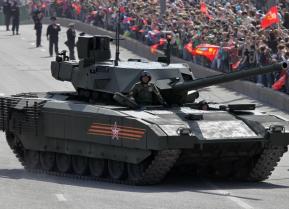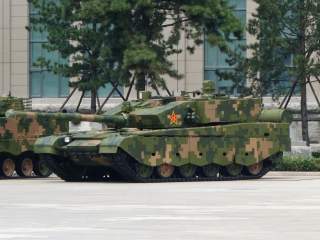Can China's Tanks Take on America's M1 Abrams or Russia's New Armata?
Beijing might not like our answer.
What's up with China's tanks? Can they keep up with the Armata and the M1A2D?
One interesting aspect of China’s tank fleet is that all of the designs are relatively young compared to European, American or Russian designs. Most of the predominant tank designs in the world originated in the late 1970s or early 1980s, but China’s ZTZ-96 and ZTZ-99 tanks only began development in the late 1980s and entered service in the late 1990s and early 2000s. But have Chinese designers taken advantage of the advances in technology that have occurred during the meantime?
The ZTZ-96 could be considered China’s first modern main battle tank. It grew out of a program to modernize the older ZTZ-88 tank, which was a stopgap design between the older Type 59s for the 1980s. The first ZTZ-96 was adopted in 1999.
It swapped the 105mm cannon that armed the earlier ZTZ-88s for a 125mm ZPT98 smoothbore cannon, a copy of the Soviet/Russian 2A46M. The fire control system (FCS) was based on earlier Marconi fire control systems imported and used by China. The FCS included a laser rangefinder (LRF), gun stabilization and optic stabilization (for the gunner’s sight). However for a 1999 tank, it was underpowered with only a 780hp power plant.
Overall, the tank was okay, but the armor left much to be desired. The armor was still a relatively old composite design, which would be almost totally ineffective against contemporary Russian and Western designs. For reference, the US was fielding M829A2 at the time, which was meant to cut through Russian tanks with heavy Kontakt-5 Explosive Reactive Armor (ERA) in front of composite armor. The basic ZTZ-96 did not even have light ERA.
As a result, armor upgrades composed the bulk of the changes when it came to the ZTZ-96A, adopted in 2009. It added on significant amounts of armor to the basic ZTZ-96 chassis, then added ERA on top of that. As a result, the ZTZ-96A has a significantly different turret shape than the basic ZTZ-96. Slat armor was also removed on other portions of the tank and replaced by ERA. Some technology used to make the turret was taken from the later ZTZ-99.
The FCS and turret controls received a slight upgrade as well, though nothing too important. A laser-warning receiver was also added to the rear of the turret to improve defensive capabilities. A thermal imager was also added in the ZTZ-96A.
The weight of all these upgrades caused the ZTZ-96A to be rather underpowered with its 780hp power plant. Chinese tankers who utilized the ZTZ-96A during the 2014 Russian Tank Biathlon complained about being left in the dust by T-72B3s, which utilized more powerful 1000hp engines.
As a result, the ZTZ-96B upgrade includes a substantial engine upgrade, up to 1130hp. It also adds new FCS, crew environmental systems, and a remote weapons station. Other upgrades are also possible, but details on the ZTZ-96B are hard to come by as it is a very recent upgrade.
Despite the upgrades, the ZTZ-96B is based on very old designs. The Chinese military has known this for a long time: the ZTZ-99 was in development concurrently with the ZTZ-96B. As opposed to the ZTZ-96, which was meant to also kind of be a “stopgap” tank, the ZTZ-99 was meant to be a true competitor to international designs like the Abrams, Leopard 2 and T-80.
The design of the first ZTZ-99s was finalized around 1998, and the tank was first seen on parade in 1999. These pre-production models feature flat turret faces and are armed with the same 125mm cannon that the ZTZ-96 uses.
The basic model of the ZTZ-99 (9910) was equipped with an independent commander’s sight, a significant improvement over the ZTZ-96 and a feature the M1A1, Leopard 2A4, and T-72B lack. It also features a 1200hp engine in the basic model, which is more powerful than basic T-72B3s.
Recommended: Imagine a U.S. Air Force That Never Built the B-52 Bomber
Recommended: Russia's Next Big Military Sale - To Mexico?
Recommended: Would China Really Invade Taiwan?
However, this design did not enter production due to perceived flaws in its armor layout and design. Rather, the tank went back into development. A slightly revised version called ZTZ-99 Phase-I Improved entered production. In 2008, further development was completed, resulting in the ZTZ-99 Phase-II. This new iteration featured angled turret faces similar to the Leopard 2A5, and ERA modules on the hull.
The entire tank underwent a large redesign yet again in the ZTZ-99A, where a new, more powerful 1500hp engine was placed in the tank. The hull’s shape is redesigned, and now resembles the M1 Abrams series of tanks with a rough wedge shape more than the Soviet T-series earlier hulls resembled. The turret is also redesigned, being wider and featuring thicker armor. The tank also has all the features you’d expect on a modern tank: thermal commander and gunner’s sights, hunter-killer capability, a soft-kill APS with laser warning receiver.
So how capable are the ZTZ-96 and ZTZ-99 in all their variants? The ZTZ-96B probably still relatively weak compared to other “frontline” tanks due to its antiquated armor. ERA can only improve armor so much. With the 125mm gun and modern fire control system, it likely will prove a lethal threat to targets, albeit one that is easily knocked out.
The ZTZ-99A is another beast. Given its armor and advanced networked and sensor systems, it’s likely to be a tough opponent. However, the quality of Chinese thermal imagers is uncertain. The latest American M1A2C tanks are said to be equipped with third generation thermal imagers, which may increase detection and identification ranges out past earlier Chinese thermals, giving the Abrams the edge. The existence of such a site does put it in front of most T-72B3s.
The Chinese tanks also use Russian/Soviet-style carousel autoloaders, which will probably not be very safe for the crew in the event of a hit. It’s surprising that the ZTZ-99A was not designed with a bustle autoloader, as many later third generation tank designs (including the Japanese Type 90 and Type 10 and Korean K2) utilize bustle autoloaders for increased safety. It’s possible Chinese designers thought the additional complexity and cost were not worth it.
In the end, the ZTZ-99A is likely a lethal threat for the older tanks in the American tank fleet and the majority of the Russian tank fleet, but both the latest versions of American and Russian tanks are likely to beat it in a fight. The constant flux of basic turret and hull designs being manufactured suggests that China is not really sure what its requirements for a tank are, and thus the ZTZ-99A is probably fairly developmentally immature, at least in contrast to the latest American and Russian tanks.
The M1A2D and Armata are likely to leave the ZTZ-99A in the dust. It’s unlikely for the Chinese military leadership will want to prioritize another new tank project, however, as the PLAN seems to have been the focus of recent developments.
Some details taken from The Technical Development of China's Tanks from the Type 59 to the Type 88 Main Battle Tank by Wu Zheren and Hu Xiaofang.
Charlie Gao studied Political and Computer Science at Grinnell College and is a frequent commentator on defense and national security issues.


